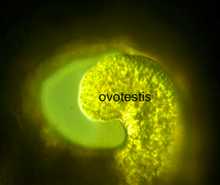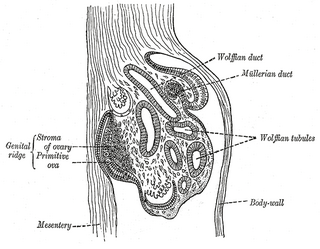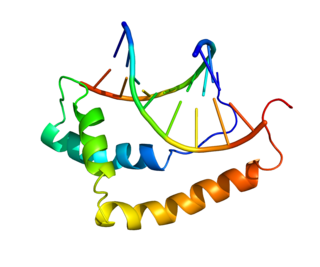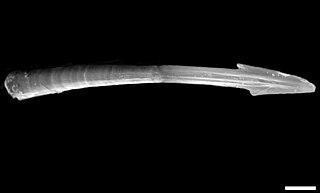In gastropods

An ovotestis or hermaphroditic gland (Latin : glandula hermaphroditica), [7] is found as normal anatomical feature in the reproductive system of some gastropods including such species as the land snail Cornu aspersum . [8]
An ovotestis is a gonad with both testicular and ovarian aspects. [1] [2] In humans, ovotestes are an infrequent anatomical variation associated with gonadal dysgenesis. [3] The only mammals where ovotestes are not symptomatic of a disorder are moles, wherein females possess ovotestes along with a masculinized clitoris. These ovotestes in nonpregnant female moles secrete eight times as much testosterone as the ovotestes of pregnant moles. [4] In invertebrates that are normally hermaphroditic, such as most gastropods (snails and slugs) in the clade Eupulmonata, an ovotestis is a common feature of the reproductive anatomy.
In mice, ovotestes are structured such that the central region is testicular tissue while the poles both contain ovarian tissue. Experiments involving the SOX9 gene, which is initiated by the SRY region of the Y chromosome, have shown the gene's requirement for testicular differentiation from the presence of ovotestis formation within XX Sox9 trangenic mice. (6) Ovotestis within B6-XYPOS mice allow for gonadal development research within the same tissue to take place in ways previously unavailable. [5] [6]

An ovotestis or hermaphroditic gland (Latin : glandula hermaphroditica), [7] is found as normal anatomical feature in the reproductive system of some gastropods including such species as the land snail Cornu aspersum . [8]

A gonad, sex gland, or reproductive gland is a mixed gland that produces the gametes and sex hormones of an organism. Female reproductive cells are egg cells, and male reproductive cells are sperm. The male gonad, the testicle, produces sperm in the form of spermatozoa. The female gonad, the ovary, produces egg cells. Both of these gametes are haploid cells. Some hermaphroditic animals have a type of gonad called an ovotestis.

Sexual differentiation is the process of development of the sex differences between males and females from an undifferentiated zygote. Sex determination is often distinct from sex differentiation; sex determination is the designation for the development stage towards either male or female, while sex differentiation is the pathway towards the development of the phenotype.

Sex-determining region Y protein (SRY), or testis-determining factor (TDF), is a DNA-binding protein encoded by the SRY gene that is responsible for the initiation of male sex determination in therian mammals. SRY is an intronless sex-determining gene on the Y chromosome. Mutations in this gene lead to a range of disorders of sex development with varying effects on an individual's phenotype and genotype.

The paired gubernacula, also called the caudal genital ligament, are embryonic structures which begin as undifferentiated mesenchyme attaching to the caudal end of the gonads.

XX male syndrome, also known as de la Chapelle syndrome, is a rare condition in which an individual with a 46,XX karyotype develops a male phenotype. Synonyms for XX male syndrome include 46,XX testicular difference of sex development

Ovotesticular syndrome is a rare congenital condition where an individual is born with both ovarian and testicular tissue. It is one of the rarest DSDs, with only 500 reported cases. Commonly, one or both gonads is an ovotestis containing both types of tissue. Although it is similar in some ways to mixed gonadal dysgenesis, the conditions can be distinguished histologically.

Sex cords are embryonic structures which eventually will give rise (differentiate) to the adult gonads. They are formed from the genital ridges - which will develop into the gonads - in the first 2 months of gestation which depending on the sex of the embryo will give rise to male or female sex cords. These epithelial cells penetrate and invade the underlying mesenchyme to form the primitive sex cords. This occurs shortly before and during the arrival of the primordial germ cells (PGCs) to the paired genital ridges. If there is a Y chromosome present, testicular cords will develop via the Sry gene : repressing the female sex cord genes and activating the male. If there is no Y chromosome present the opposite will occur, developing ovarian cords. Prior to giving rise to sex cords, both XX and XY embryos have Müllerian ducts and Wolffian ducts. One of these structures will be repressed to induce the other to further differentiate into the external genitalia.

The genital ridge is the precursor to the gonads. The genital ridge initially consists mainly of mesenchyme and cells of underlying mesonephric origin. Once oogonia enter this area they attempt to associate with these somatic cells. Development proceeds and the oogonia become fully surrounded by a layer of cells.

Gonadal dysgenesis is classified as any congenital developmental disorder of the reproductive system in humans. It is atypical development of gonads in an embryo. One type of gonadal dysgenesis is the development of functionless, fibrous tissue, termed streak gonads, instead of reproductive tissue. Streak gonads are a form of aplasia, resulting in hormonal failure that manifests as sexual infantism and infertility, with no initiation of puberty and secondary sex characteristics.

Sexual differentiation in humans is the process of development of sex differences in humans. It is defined as the development of phenotypic structures consequent to the action of hormones produced following gonadal determination. Sexual differentiation includes development of different genitalia and the internal genital tracts and body hair plays a role in sex identification.
The development of the gonads is part of the prenatal development of the reproductive system and ultimately forms the testicles in males and the ovaries in females. The immature ova originate from cells from the dorsal endoderm of the yolk sac. Once they have reached the gonadal ridge they are called oogonia. Development proceeds and the oogonia become fully surrounded by a layer of connective tissue cells. In this way, the rudiments of the ovarian follicles are formed.

WNT4 is a secreted protein that, in humans, is encoded by the WNT4 gene, found on chromosome 1. It promotes female sex development and represses male sex development. Loss of function may have consequences, such as female to male sex reversal.

Transcription factor SOX-9 is a protein that in humans is encoded by the SOX9 gene.

A hermaphrodite is a sexually reproducing organism that produces both male and female gametes. Animal species in which individuals are of different sexes, either male or female but not both, are gonochoric, which is the opposite of hermaphroditic.

A love dart is a sharp, calcareous or chitinous dart which some hermaphroditic land snails and slugs create. Love darts are both formed and stored internally in a dart sac. These darts are made in sexually mature animals only, and are used as part of the sequence of events during courtship, before actual mating takes place. Darts are quite large compared to the size of the animal: in the case of the semi-slug genus Parmarion, the length of a dart can be up to one fifth that of the semi-slug's foot.

The reproductive system of gastropods varies greatly from one group to another within this very large and diverse taxonomic class of animals. Their reproductive strategies also vary greatly.
46,XX/46,XY is a chimeric genetic condition characterized by the presence of some cells that express a 46,XX karyotype and some cells that express a 46,XY karyotype in a single human being. The cause of the condition lies in utero with the aggregation of two distinct blastocysts or zygotes into a single embryo, which subsequently leads to the development of a single individual with two distinct cell lines, instead of a pair of fraternal twins. 46,XX/46,XY chimeras are the result of the merging of two non-identical twins. This is not to be confused with mosaicism or hybridism, neither of which are chimeric conditions.
Peter Anthony Koopman is an Australian biologist best known for his role in the discovery and study of the mammalian Y-chromosomal sex-determining gene, Sry.
Intersex is a general term for an organism that has sex characteristics that are between male and female. It typically applies to a minority of members of gonochoric animal species such as mammals. Such organisms are usually sterile.

Four Core Genotypes (FCG) mice are laboratory mice produced by genetic engineering that allow biomedical researchers to determine if a sex difference in phenotype is caused by effects of gonadal hormones or sex chromosome genes. The four genotypes include XX and XY mice with ovaries, and XX and XY mice with testes. The comparison of XX and XY mice with the same type of gonad reveals sex differences in phenotypes that are caused by sex chromosome genes. The comparison of mice with different gonads but the same sex chromosomes reveals sex differences in phenotypes that are caused by gonadal hormones.